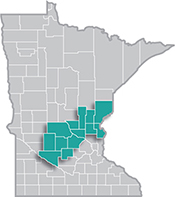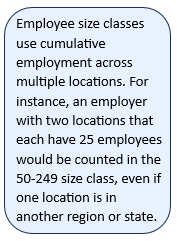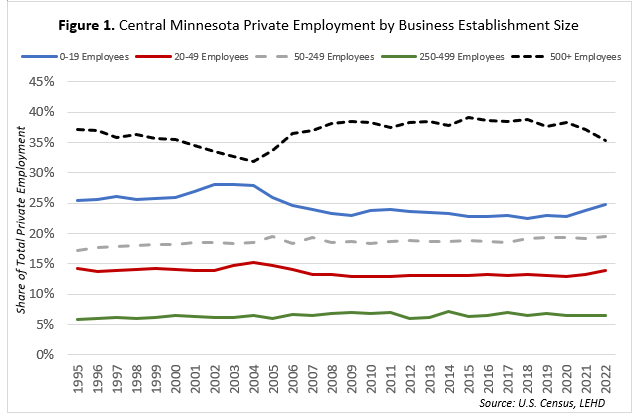 Central Minnesota is a manufacturing stronghold, with several global manufacturing firms operating there.
Central Minnesota is a manufacturing stronghold, with several global manufacturing firms operating there.
The region is especially well known for its expertise in food processing, printing, furniture manufacturing, appliances, machinery and heavy equipment manufacturing.
View our latest blogs on CareerForce. Want the freshest data delivered by email? Subscribe to our regional newsletters.
4/23/2024 9:00:00 AM
Luke Greiner
 Central Minnesota stands as a microcosm of economic activity, where the size and composition of businesses reflect broader employment trends. Despite the dynamic nature of the business world, a significant portion of establishments across various industries have demonstrated remarkable resilience in maintaining their size over time. While fluctuations and shifts occur within individual sectors and regions, many businesses have found stability in their operations and scale.
Central Minnesota stands as a microcosm of economic activity, where the size and composition of businesses reflect broader employment trends. Despite the dynamic nature of the business world, a significant portion of establishments across various industries have demonstrated remarkable resilience in maintaining their size over time. While fluctuations and shifts occur within individual sectors and regions, many businesses have found stability in their operations and scale.
According to data from the Quarterly Workforce Indicators program, in the mid 1990's about 26% of jobs were held at private business establishments that employed fewer than 20 workers. By 2022, that share had changed just one percentage point to 25%. Meanwhile, the share of jobs held at the largest businesses (500+ employees) declined slightly from 37% to 35%. The largest fluctuations in share occurred during recessionary periods, with the number and percentage of workers in smaller businesses increasing the most since 2020 (see Figure 1).

Whether fueled by niche markets, loyal customer bases or efficient operational models, central Minnesota businesses have weathered economic cycles and competitive pressures, often carving out enduring positions within their respective markets.
However, specific industries have experienced significant changes that are sometimes obscured by overarching economic trends. For instance, Retail Trade has experienced a dramatic shift since the 1990's, when a quarter of jobs were held at businesses with less than 20 employees, compared to just 18% in 2022. This is a 27% decline in the share of workers at these small Retail Trade establishments, even as the actual number of jobs at small retailers has slowly continued to grow, from 32,325 in 1995 to 35,041 in 2022.
In contrast, two decades ago roughly 46% of Retail Trade employment in Central Minnesota was at establishments that cumulatively had 500 or more employees, and by the 2020s that share had climbed to 57%, an increase of 18%, equivalent to about 4,600 more jobs at the largest retail establishments. The challenges faced by small retailers underscore deeper structural transformations in the economy, characterized by the rise of digital commerce, globalization and evolving consumer behaviors.
Contact Luke Greiner, Labor Market Analyst, at luke.greiner@state.mn.us